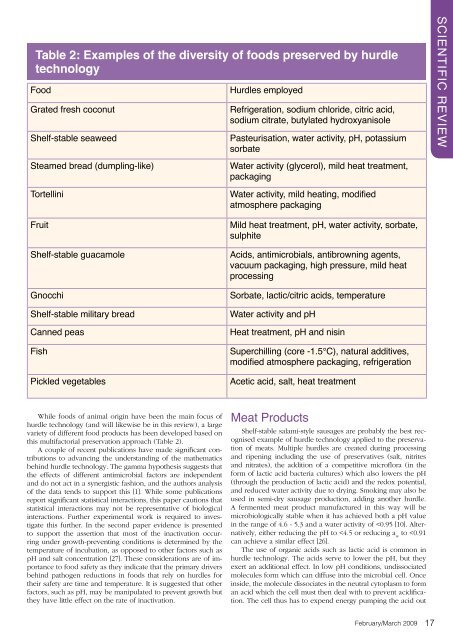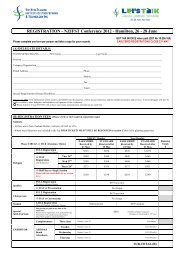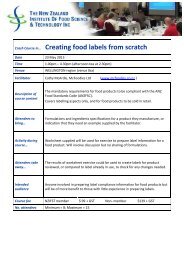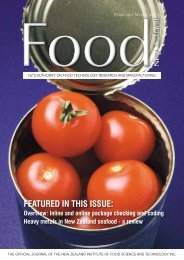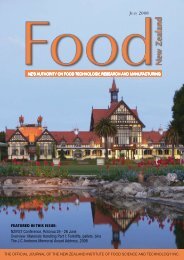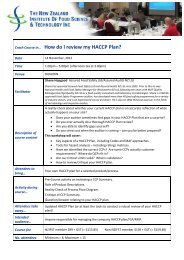featured in this issue - NZIFST - The New Zealand Institute of Food ...
featured in this issue - NZIFST - The New Zealand Institute of Food ...
featured in this issue - NZIFST - The New Zealand Institute of Food ...
You also want an ePaper? Increase the reach of your titles
YUMPU automatically turns print PDFs into web optimized ePapers that Google loves.
Table 2: Examples <strong>of</strong> the diversity <strong>of</strong> foods preserved by hurdle<br />
technology<br />
<strong>Food</strong><br />
Grated fresh coconut<br />
Shelf-stable seaweed<br />
Hurdles employed<br />
Refrigeration, sodium chloride, citric acid,<br />
sodium citrate, butylated hydroxyanisole<br />
Pasteurisation, water activity, pH, potassium<br />
sorbate<br />
SCIENTIFIC REVIEW<br />
Steamed bread (dumpl<strong>in</strong>g-like)<br />
Tortell<strong>in</strong>i<br />
Fruit<br />
Shelf-stable guacamole<br />
Gnocchi<br />
Shelf-stable military bread<br />
Canned peas<br />
Fish<br />
Pickled vegetables<br />
Water activity (glycerol), mild heat treatment,<br />
packag<strong>in</strong>g<br />
Water activity, mild heat<strong>in</strong>g, modified<br />
atmosphere packag<strong>in</strong>g<br />
Mild heat treatment, pH, water activity, sorbate,<br />
sulphite<br />
Acids, antimicrobials, antibrown<strong>in</strong>g agents,<br />
vacuum packag<strong>in</strong>g, high pressure, mild heat<br />
process<strong>in</strong>g<br />
Sorbate, lactic/citric acids, temperature<br />
Water activity and pH<br />
Heat treatment, pH and nis<strong>in</strong><br />
Superchill<strong>in</strong>g (core -1.5°C), natural additives,<br />
modified atmosphere packag<strong>in</strong>g, refrigeration<br />
Acetic acid, salt, heat treatment<br />
While foods <strong>of</strong> animal orig<strong>in</strong> have been the ma<strong>in</strong> focus <strong>of</strong><br />
hurdle technology (and will likewise be <strong>in</strong> <strong>this</strong> review), a large<br />
variety <strong>of</strong> different food products has been developed based on<br />
<strong>this</strong> multifactorial preservation approach (Table 2).<br />
A couple <strong>of</strong> recent publications have made significant contributions<br />
to advanc<strong>in</strong>g the understand<strong>in</strong>g <strong>of</strong> the mathematics<br />
beh<strong>in</strong>d hurdle technology. <strong>The</strong> gamma hypothesis suggests that<br />
the effects <strong>of</strong> different antimicrobial factors are <strong>in</strong>dependent<br />
and do not act <strong>in</strong> a synergistic fashion, and the authors analysis<br />
<strong>of</strong> the data tends to support <strong>this</strong> [1]. While some publications<br />
report significant statistical <strong>in</strong>teractions, <strong>this</strong> paper cautions that<br />
statistical <strong>in</strong>teractions may not be representative <strong>of</strong> biological<br />
<strong>in</strong>teractions. Further experimental work is required to <strong>in</strong>vestigate<br />
<strong>this</strong> further. In the second paper evidence is presented<br />
to support the assertion that most <strong>of</strong> the <strong>in</strong>activation occurr<strong>in</strong>g<br />
under growth-prevent<strong>in</strong>g conditions is determ<strong>in</strong>ed by the<br />
temperature <strong>of</strong> <strong>in</strong>cubation, as opposed to other factors such as<br />
pH and salt concentration [27]. <strong>The</strong>se considerations are <strong>of</strong> importance<br />
to food safety as they <strong>in</strong>dicate that the primary drivers<br />
beh<strong>in</strong>d pathogen reductions <strong>in</strong> foods that rely on hurdles for<br />
their safety are time and temperature. It is suggested that other<br />
factors, such as pH, may be manipulated to prevent growth but<br />
they have little effect on the rate <strong>of</strong> <strong>in</strong>activation.<br />
Meat Products<br />
Shelf-stable salami-style sausages are probably the best recognised<br />
example <strong>of</strong> hurdle technology applied to the preservation<br />
<strong>of</strong> meats. Multiple hurdles are created dur<strong>in</strong>g process<strong>in</strong>g<br />
and ripen<strong>in</strong>g <strong>in</strong>clud<strong>in</strong>g the use <strong>of</strong> preservatives (salt, nitrites<br />
and nitrates), the addition <strong>of</strong> a competitive micr<strong>of</strong>lora (<strong>in</strong> the<br />
form <strong>of</strong> lactic acid bacteria cultures) which also lowers the pH<br />
(through the production <strong>of</strong> lactic acid) and the redox potential,<br />
and reduced water activity due to dry<strong>in</strong>g. Smok<strong>in</strong>g may also be<br />
used <strong>in</strong> semi-dry sausage production, add<strong>in</strong>g another hurdle.<br />
A fermented meat product manufactured <strong>in</strong> <strong>this</strong> way will be<br />
microbiologically stable when it has achieved both a pH value<br />
<strong>in</strong> the range <strong>of</strong> 4.6 - 5.3 and a water activity <strong>of</strong>


